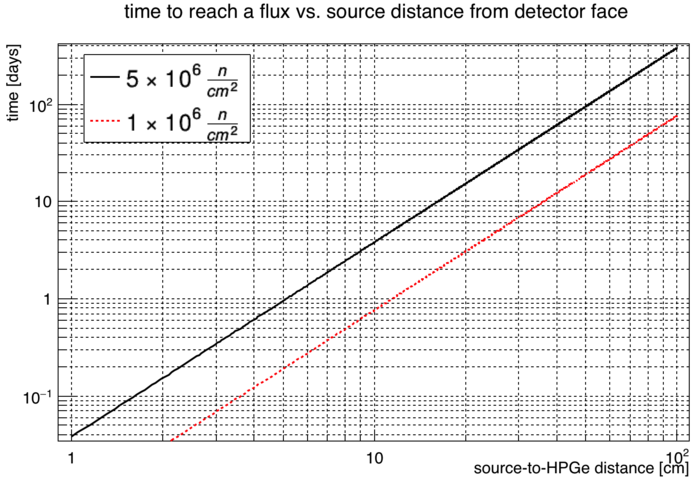Difference between revisions of "Fast neutron damage to HPGe Detector"
| Line 1: | Line 1: | ||
A observable decrease in the energy resolution of a large HPGe was first seen after the irradiation of 5*10^7 n/cm^2<ref>P. H. Stelson, J. K. Dickens, S. Raman, and R. C. Trammell, “Deterioration of Large Ge(Li) Diodes Caused by Fast Neutrons,” Nuclear Instruments and Methods 98,481 (1972).</ref>, so 5*10^6 n/cm^2 is a conservative number to stay under. | A observable decrease in the energy resolution of a large HPGe was first seen after the irradiation of 5*10^7 n/cm^2<ref>P. H. Stelson, J. K. Dickens, S. Raman, and R. C. Trammell, “Deterioration of Large Ge(Li) Diodes Caused by Fast Neutrons,” Nuclear Instruments and Methods 98,481 (1972).</ref>, so 5*10^6 n/cm^2 is a conservative number to stay under. | ||
| − | The maximum neutron flux occurs right at the center of the detector, where the expression for integral flux is simply: <math>\Delta t n_{rate}\frac{1}{4\pi d^2}</math>. | + | The maximum neutron flux occurs right at the center of the detector, where the expression for integral flux is simply: <math>\Delta t\times n_{rate}\frac{1}{4\pi d^2}</math>. |
The number of days it would take to reach an integral flux of 5*10^6 n/cm^2, as a function of the distance from source to HPGe face is shown below. The graph assumes the activity of the Cf-252 source as of 01/2017, which is 19,066 n/s. | The number of days it would take to reach an integral flux of 5*10^6 n/cm^2, as a function of the distance from source to HPGe face is shown below. The graph assumes the activity of the Cf-252 source as of 01/2017, which is 19,066 n/s. | ||
Revision as of 06:41, 29 December 2016
A observable decrease in the energy resolution of a large HPGe was first seen after the irradiation of 5*10^7 n/cm^2<ref>P. H. Stelson, J. K. Dickens, S. Raman, and R. C. Trammell, “Deterioration of Large Ge(Li) Diodes Caused by Fast Neutrons,” Nuclear Instruments and Methods 98,481 (1972).</ref>, so 5*10^6 n/cm^2 is a conservative number to stay under.
The maximum neutron flux occurs right at the center of the detector, where the expression for integral flux is simply: .
The number of days it would take to reach an integral flux of 5*10^6 n/cm^2, as a function of the distance from source to HPGe face is shown below. The graph assumes the activity of the Cf-252 source as of 01/2017, which is 19,066 n/s.
Formula used in the graph above :
References
<references />
